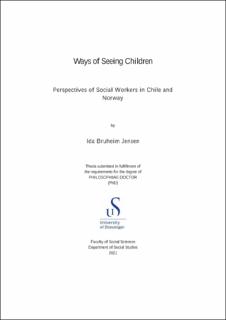| dc.contributor.advisor | Studsrød, Ingunn | |
| dc.contributor.advisor | Ellingsen, Ingunn | |
| dc.contributor.author | Jensen, Ida Bruheim | |
| dc.coverage.spatial | Chile & Norway | en_US |
| dc.date.accessioned | 2021-05-26T06:22:31Z | |
| dc.date.available | 2021-05-26T06:22:31Z | |
| dc.date.issued | 2021-05 | |
| dc.identifier.citation | Ways of Seeing Children: Perspectives of Social Workers in Chile and Norway by Ida Bruheim Jensen, Stavanger : University of Stavanger, 2021 (PhD thesis UiS, no. 588) | en_US |
| dc.identifier.issn | 1890-1387 | |
| dc.identifier.uri | https://hdl.handle.net/11250/2756359 | |
| dc.description.abstract | The overall aim of this project was to gain extended insights into social workers’ perspectives of children in child protection work in Chile and Norway. Q methodology was applied to meet this aim, as it is suitable for exploring and comparing subjective perspectives. The findings are based on the perspectives of 38 social workers (21 in Chile and 17 in Norway). This project adopts an exploratory design, and during the research process, I discovered that a review of previous research on social workers’ perspectives of children in child protection work was lacking from the literature. Hence, the second aim of this project was to fill a research gap in the literature by providing a comprehensive portrayal of child protection social workers’ constructions of children through an integrative review.
The body of this dissertation contains three research papers. Paper 1 explores child protection social workers’ practices and ideas about children and childhood in existing research. Findings are based on an analysis and synthesis of 35 empirical articles. Papers 2 and 3 present findings from the Q methodological study. While Paper 2 focuses on the perspectives of children among social workers in Chile (n=21), Paper 3 has a comparative approach to study the perspectives of children among social workers in Norway and Chile (n=38).
The findings show that social workers in Norway are inclined to see children’s independence, while social workers in Chile tend to see children as relationally and structurally conditioned. Conducting an analysis and synthesis of previous research enabled a juxtaposition of findings from Chile and Norway against what was found in the integrative review. A key finding of the review is that children generally were understood in light of psychological knowledge such as developmental psychology, attachment theories and individualistic psychology. Less focus was directed towards contextual knowledge of children such as children’s neighbourhoods, friends and teachers and variation among children. A predominance of studies in the review were from U.K. or other Northern European countries. Hence, a key question that transpired from looking at findings across the three papers is whether the independent child is a predominant understanding of children among child protection workers in Northern European countries. There is still a lack of research, particularly in English, on social worker perspectives in Latin America. An important focus for future research should be to explore whether the perspective emphasising the relational and structural child that was reflected among the social workers in Chile transcends to a more general level among social workers in Chile and possibly to other Latin American countries. If these findings are identified in more large-scale studies, they may contribute to the building blocks of empirical and theoretical understandings, for example, regarding current knowledge on child protection systems. Moreover, such findings may extend the knowledge of how children’s rights are balanced among social workers internationally.
This project contributes to extending previous knowledge by illuminating perspectives of children in child protection work among social workers in different welfare contexts. The perspectives identified in this study indicate different ways of seeing children which may orient social workers’ attention towards some aspects and away from others, particularly regarding the independent versus relational child. These orientations may have significant implications for interpretations and decisions made in child protection work. | en_US |
| dc.language.iso | eng | en_US |
| dc.publisher | University of Stavanger, Norway | en_US |
| dc.relation.ispartofseries | PhD thesis UiS; | |
| dc.relation.ispartofseries | ;588 | |
| dc.relation.haspart | Paper 1: Jensen, I. B., Studsrød, I., & Ellingsen, I. T. (2019). Child protection social workers’ constructions of children and childhood: An integrative review. Child & Family Social Work, 25(S1), 83-96. | en_US |
| dc.relation.haspart | Paper 2: Jensen, I. B., Ellingsen, I. T., Studsrød, I., & Quiroga, M. G. (2019). Children and childhood in Chile: Social worker perspectives. Journal of Comparative Social Work, 14(1), 141-164. | en_US |
| dc.relation.haspart | Paper 3: Jensen, I. B. (2020). What are the perspectives of children in child protection work among social workers in Norway and Chile?. Children and Youth Services Review, 118, 1-10. | en_US |
| dc.rights | Copyright the author | |
| dc.subject | sosialt arbeid | en_US |
| dc.subject | barnevern | en_US |
| dc.subject | Chile | en_US |
| dc.subject | Norge | en_US |
| dc.subject | Q-metodologi | en_US |
| dc.title | Ways of Seeing Children: Perspectives of Social Workers in Chile and Norway. | en_US |
| dc.type | Doctoral thesis | en_US |
| dc.rights.holder | © 2021 Ida Bruheim Jensen | en_US |
| dc.subject.nsi | VDP::Samfunnsvitenskap: 200::Sosialt arbeid: 360 | en_US |
